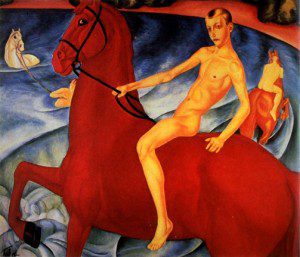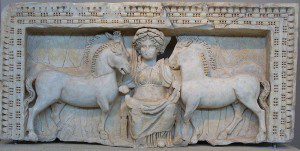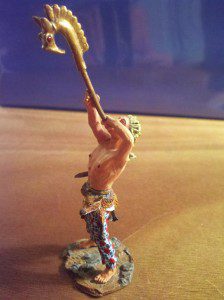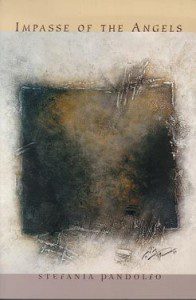 Red horses are racing above mountain tops. They are flying over the hills, immense and powerful. Plumes of steam rise from their nostrils. From the steam, men fall to the ground; they appear to be tiny stick figures in proportion to the horses.
Red horses are racing above mountain tops. They are flying over the hills, immense and powerful. Plumes of steam rise from their nostrils. From the steam, men fall to the ground; they appear to be tiny stick figures in proportion to the horses.
A huge raven soars above a place where water is swirling, counter-clockwise and clockwise, between the mountains. The twin pools are also labyrinths.
Between the pools is a pathway along which a splendid red horse is prancing. It becomes a lovely woman with streaming red hair. She wears a green robe, with a band of golden keys along the hem. I am awed by her beauty and power.
The stick-men are gathered up by priestesses, who are giants in proportion to them. Half are placed in one pool, the other half in the other. The men revive and grow in size. They are assembled at the center of each pool, in great numbers.
This is the dream of an American woman, shared in one of my circles. She was mystified by the red horses, and knew very little about the Old World traditions of red horses and goddesses in green and gold. In our explorations, we learned, once again, that spontaneous night dreams can open doors between the worlds, and take us into imaginal realities inhabited by the gods, demons and ancestors of different cultures – even when we have little or no prior conscious knowledge of those cultures.
Red horses are Death Horses in Irish legend. When I looked inside the dream – in a group exercise in shamanic tracking – I saw that the men who were falling through the steam were men who had died, in one sense or another. The twin pools, or water labyrinths, were gates to alternative afterlife situations. Those who went into the pool on the left – the one where things moved counter-clockwise – would go down and stay close; they would be held in a realm close to the earth for cleansing and reeducation. They included criminals and abusers. Their choices would be limited. They were not exactly bound for “hell”, but for places where an enlightened being would not want to be. Their pool could be seen, nonetheless, as a place of healing – of soul cleansing and restoration. The pool on the right offered many more options, including that of traveling upward to a place where new life/afterlife choices will be made. This one seemed to turn sunwise, ie clockwise.
The beautiful red-haired horsewoman, as I saw her, was Epona, a Celtic horse goddess who may be related to the Rhiannon of Welsh myth. I had not realized until now that she is a Death Goddess, among her other guises. But then, a great goddess can be whatever she chooses! And my research quickly confirmed what was learned in tracking the dream.
 Epona’s name comes from the Gaulish epos, “horse”. She is usually depicted riding side-saddle on a mare or between twin horses. She was hugely popular in Gaul and the Rhineland, but was also known in Britain. She was regarded as a patron by cavalrymen; the Aedui, used as auxiliaries by Julius Caesar, prayed to her to protect their horses (and themselves) in battle. To the wider community, she was a Mother Goddess, and her imagery often suggests fertility; on a stone relief of Epona at Brazey inBurgundy, a foal is beneath the mare she is riding, possibly suckling. She often appears carrying baskets of fruit or loaves of bread. She was awarded her own official festival in the Roman calendar, on December 18.
Epona’s name comes from the Gaulish epos, “horse”. She is usually depicted riding side-saddle on a mare or between twin horses. She was hugely popular in Gaul and the Rhineland, but was also known in Britain. She was regarded as a patron by cavalrymen; the Aedui, used as auxiliaries by Julius Caesar, prayed to her to protect their horses (and themselves) in battle. To the wider community, she was a Mother Goddess, and her imagery often suggests fertility; on a stone relief of Epona at Brazey inBurgundy, a foal is beneath the mare she is riding, possibly suckling. She often appears carrying baskets of fruit or loaves of bread. She was awarded her own official festival in the Roman calendar, on December 18.
Miranda Green comments, in her excellent book Animals in Celtic Life and Myth, “The horse is absolutely crucial to Epona’s definition: the equine symbolism gave rose to many different levels of meaning, with the result that Epona was worshipped not only as patroness of horses but also as a giver of life, health, fertility and plenty, and as a protectress of humans even beyond the grave.”
Epona was indeed associated with death and rebirth beyond the grave. She is often depicted in Gaulish cemeteries. At La Horge-au-Sablon, a burial ground of the Medioatrici at Metz (eastern Gaul) images of Epona were offered by relatives of the deceased; one depicts the goddess on her mare, leading a mortal to the Otherworld.
Tracking a dream of red horses and a red-haired horsewoman led deep into the realm of Epona, revealed her full functions as a Death Goddess in ways that were previously unknown to me and are not explained in books. Dream archaeology takes us to places even the most sensitive diggers can’t reach reach by other means!
Bathing of the Red Horses by Kuzma Petrov-Vodkin (1912)

